eOrganic authors:
Bonnie Cox, Oregon Tilth
Timothy Coolong, University of Kentucky
Introduction
Tomatoes are susceptible to a variety of non-pathogenic fruit disorders. These disorders are not infectious, but are generally the plant's response to adverse environmental conditions. Some non-pathogenic disorders can be corrected by adjusting water, temperature, or shading. Others are not fully understood or may be an interaction of genetic and physiological problems that are difficult to correct. Cultivars vary in their susceptibility to these non-pathogenic disorders.
Cool temperatures are a contributing factor to some tomato disorders, such as catfacing and puffiness. Other non-pathogenic tomato disorders are related to nutritional imbalances or deficiencies in the soil.
Common organic soil management practices can reduce the risk of some of these disorders. Organic amendment and mulching can reduce the magnitude of soil moisture fluctuations, an important contributing factor to blossom end rot and cracking. See the eOrganic article Organic Soil Fertility for more information on organic soil and fertility management.
Non-Pathogenic Fruit Disorders

Blossom end rot. Photo credit: Tim Coolong, University of Kentucky
Blossom end rot is characterized by dark brown or black sunken areas at the blossom end of the fruit. The lesions are a direct result of a localized calcium deficiency at the blossom end. Although calcium deficiencies are sometimes responsible for blossom end rot, much of the time, blossom end rot is the result of plant water stress. Calcium moves primarily in water-conducting tissues of the plant so when water movement is restricted, calcium deficiencies develop. Problems can be prevented by regular watering that avoids extreme fluctuations in soil moisture. Good soil drainage, mulching, and preventing root damage also help. Other soil factors may contribute to blossom end rot. High soluble salts, low calcium and high cation (potassium, magnesium or ammonium) levels in the soil out-compete calcium on soil exchange sites, making it unavailable to the plant. Monitoring soil soluble salts and cation ratios, and maintaining adequate calcium in the soil should help. See the eOrganic article Conventional Chemical Soil Testing within Organic Systems for more information.
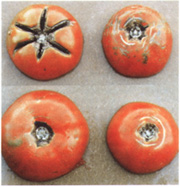
Concentric and radial cracking of tomato fruit. Photo credit: Henry Taber, Iowa State University.
Cracking of fruit can be either radial or concentric. In both types of cracking, cultivars vary considerably in their susceptibility. Radial cracks form near the stem and may extend almost to the bottom tip of the fruit. Tomatoes are more susceptible to this type of cracking as they ripen. Radial cracks are often the result of rain or excessive watering after a prolonged dry period. Maintaining even soil moisture will help prevent cracks. Concentric cracks form on the shoulders of the fruit, often appearing as rings of brown scar tissue. A form of concentric cracking called weather checking, fruit russeting, or shoulder checking results from water droplets on the fruit shoulder being exposed to full sun, often due to a lack of leafy cover and overhead irrigation. Shoulder checking can be prevented by maintaining ample healthy foliage and keeping fruit dry.
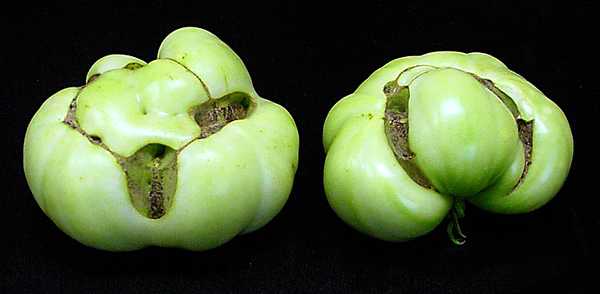
Catfacing. Photo credit: Carrie Lapaire, Purdue Plant and Pest Diagnostic Laboratory, Purdue University
Catfacing is a condition that distorts fruit growth at the blossom end. The fruit develops deep, scar-like indentations that can extend the length of the fruit. In catfacing, the female part of the flower develops abnormally due to low temperatures during flowering. Extended periods of cool daytime temperatures (60-65 degrees F) and cool nighttime temperatures (50-60 degrees F) can lead to catfacing. High tunnels, row covers, or other protections that warm air temperatures can reduce damage during flowering if field conditions are cool. Cultivars also vary considerably in their susceptibility to catfacing.

Zippering. Photo credit: Timothy Coolong, University of Kentucky
Zippering is characterized by the presence of brown tissue (resembling a zipper) running down the sides of tomatoes, often from the stem to blossom end. Zippering is the result of an anther remaining attached to newly forming fruit. Some theorize it is also associated with incomplete shedding of flower petals when fruit is forming. There is little that can be done to prevent zippering, except selecting varieties that are not prone to this disorder.
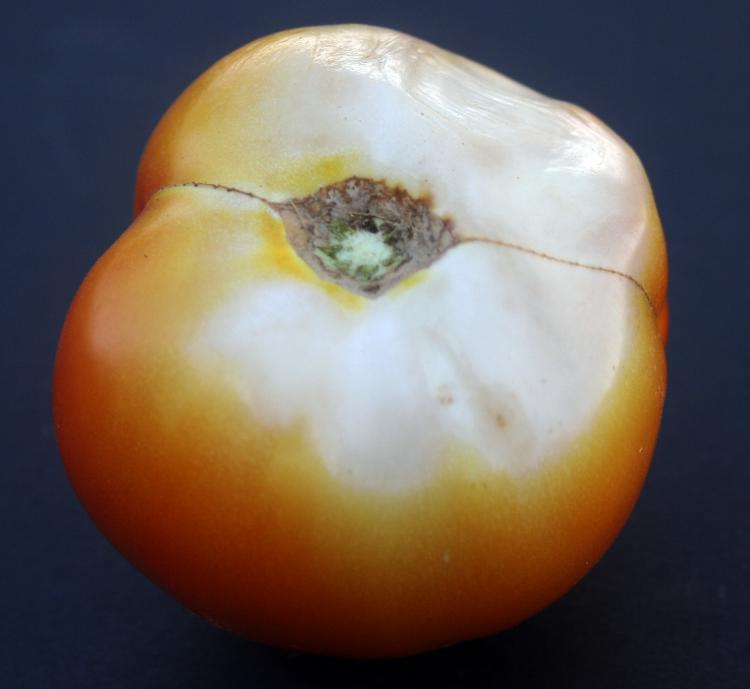
Sunscald. Photo credit: Timothy Coolong, University of Kentucky
Sunscald occurs in fruit exposed to direct sun in hot weather. Bleached and blistered areas develop on the exposed surface, eventually becoming dry and papery. The best prevention is to maintain healthy foliage by protecting against defoliating diseases, avoiding excessive pruning, and using a closer plant spacing.

Puffiness. Photo credit: Timothy Coolong, University of Kentucky
Puffiness results from poor pollination and leads to oddly-shaped fruit. The locular gel (the liquid that surrounds the seeds) fails to fill the fruit's inner cavity resulting in a fruit with flattened sides that lacks firmness. Although eating quality is poor because of the lack of gel, some cultivars have been bred to be puffy so they can be stuffed more easily. Poor pollination that leads to puffiness could be due to uncommonly cool field temperatures or, if growing greenhouse tomatoes, a lack of vibration or shaking that mixes the blossoms' pollen.

Blotchy ripening. Photo credit: Timothy Coolong, University of Kentucky
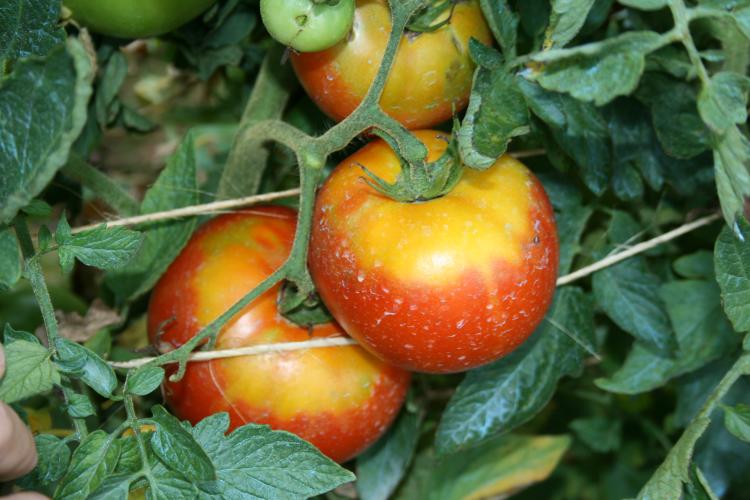
Yellow shoulder. Photo credit: Timothy Coolong, University of Kentucky
Several ripening disorders also affect tomatoes: blotchy ripening, yellow shoulder, and gray wall. Tomatoes with blotchy ripening ripen unevenly with yellow or orange discolored areas on their surface or shoulders. Yellow shoulder describes fruit discolored with green-yellow patches on the shoulders and may be accompanied by coarsely-textured fruit walls. This disorder is usually caused by heat injury and insufficient potassium. Tomatoes with gray wall have grayish-brown discolorations on the fruit wall and may also exhibit internal browning. Gray wall typically appears on green fruit before ripening. Factors that increase the severity of these disorders include cloudy weather, wet and cool conditions, high nitrogen, low potassium, and compacted soils. Good irrigation management and organic soil and nutrient management will reduce the risk of these disorders.
In California processing tomatoes, the disorders yellow shoulder and internal white tissue were shown to be strongly related to low fruit potassium content. Interestingly, fruit potassium content was more related to the ratio of the soil exchangeable potassium content divided by the square root of the soil magnesium content, than to soil exchangeable potassium content. The soil exchangeable magnesium content was also positively related to the disorder. Gypsum applications improved fruit quality (Hartz, 1999). See Organic Soil Fertility and Conventional Chemical Soil Testing within Organic Systems for information on organic nutrient management.
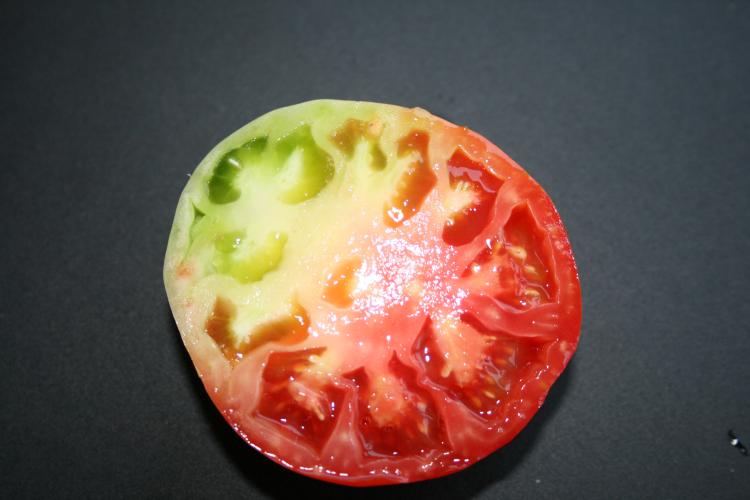
Silverleaf whitefly damage. Photo credit: Timothy Coolong
Another type of ripening disorder is caused by the Silverleaf whitefly (Bemisia argentifolii). Silverleaf whitefly larvae inject toxins into tomato fruit when feeding, leading to irregular ripening which can cause significant losses. Affected fruit will not ripen.
References and Citations:
- Hartz, T.K. 1999. Potassium requirements for maximum yield and quality of processing tomato [Online]. Better crops: Journal of the International Plant Nutrition Institute. Vol. 83 (2). Available at: http://www.ipni.net/ppiweb/bcrops.nsf/$webindex/119F859ECB4EFCB8852568EF005D82BA/$file/99-2p26.pdf (verified 19 March 2010).
- Peet, M. 1995. Sustainable practices for vegetable production in the South: tomato. Focus Publishing. Newburyport, MA.
- Swaider, J.M. and G.W. Ware. 2002. Producing vegetable crops. 5th edition. Interstate Publishers, Inc. Danville, IL.
- Zitter, T.A. and S. Reiners. 2004. Common tomato fruit disorders [Online]. Vegetable MD Online. Cornell University. Available at: http://vegetablemdonline.ppath.cornell.edu/NewsArticles/Tom_ComDis.htm (verified 19 March 2010).



